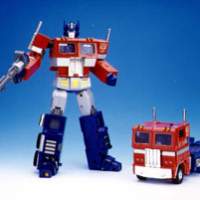What is it with Japan and robots? For whatever reason, they have been an integral part of the national psyche for decades. While Toyota's automated production lines might be the first thing that springs to mind, robotic creatures, from Astroboy to Aibo, have also become an integral part of the nation's identity.
Back in the days before "Made in Japan" was the badge of distinction it is today, and tin toys and die-cast figures were among the best-known exports, a team of robot-obsessed designers in a workshop in a run-down eastern Tokyo suburb came up with the most enduring manifestation of this powerful Japanese fantasy. Their inventions, branded as Transformers -- "the robots in disguise" -- became arguably the world's most successful action-toy lines ever, with over 300 million units shipped since their launch in 1984.
Those shape-shifting automatons are regarded as the boys' equivalent of Barbie. In the 1980s, no self-respecting preteen was without one, and the manufacturer Takaratomy (formerly Takara) still ships an average of 1 million units per year in Japan and 5 million internationally through Hasbro, its long-standing partner.
The idea of a vehicle transforming into a humanoid robot was first realized in 1980, with the release of a Lambourghini Countach sports-car model that turned into a menacing mech warrior. The pioneer toy in Takara's Diaclone series, that car/warrior combo would later reappear in the Transformers series as Autobot stalwart Sunstreaker, after Hasbro executives saw the potential of the series and offered to team up with Takara on a worldwide launch.
Finding a balance
The rapid and rampant success of the project spawned many imitators around the world, but none could match the marketing muscle of the Takara/Hasbro partnership.
The secret of the toys' enduring appeal lay in them offering two distinctive play patterns. "There are two ways to play with them," said Hideaki Yoke, manager of the team behind this world-conquering plaything. "There's the character, action-figure thing, and there's the mechanical transformation process -- finding a balance between the two is our job. If you make it too difficult, young kids lose interest."
Kojin Ohno, Yoke's right-hand man for more than 20 years, and the inventor of many classic designs in the long-running series, added that coming up with simple but striking transformations is the key to success in their business. "It's easy to invent complex transformations," he said. "But it's the simple ones that are most difficult to design."
That goal of simplicity notwithstanding, some of the team's creations are incredibly complex, featuring more than 20 points of articulation. Consequently, Yoke said, it usually takes over two years -- and hundreds of man hours -- to progress one model from the drawing board to toy store shelves.
Countless parents whose children have spent hours figuring out how to transform their newly acquired companions can thank these talented Tokyo obsessives for all those precious moments of peace and quiet that the shape-shifting hulks provide. As those kids grow up, some of them move on to competitive transforming against the clock at events held regularly at toy fairs all over the world.
Among the particularly ingenious metamorphoses created by the Takara team have been a cassette recorder that turned into a rocket-toting bad guy, and Astrotrain, a "triple changer" that turned from a space shuttle into a train and then into a sword-wielding robot warrior.
Courageous and dastardly
Although the series' fortunes have waned in recent years as toys have gone even more high-tech in the computer age, soon enough a whole new generation of kids is going to be inducted into the world of the courageous Autobots and dastardly Decepticons. A live-action Transformers movie backed by Steven Spielberg and his Dreamworks studio is slated for release on July 4, 2007. It will be directed by Michael Bay, of "Pearl Harbor" fame, and will coincide with the launch of a new line of even more dynamic and ingenious toys designed by the Takatomy team.
The movie's co-producer Tom DeSanto praised the lasting appeal of the Transformers mythology in a recent interview, saying that "even though they're robots, the characters have a lot of personality and a lot of heart and people still care about them."
That is the beauty of the series, and besides the samurai helmets and kabuki-style scowling faces seen on many of the designs, it continues to mean that as far as their young owners are concerned, these toys are regarded almost as thinking and feeling beings.
"Freedom is the right of all sentient beings" is the famed motto of superstar transformer Optimus Prime -- the implication being that, in a very Japanese animist conception, even robots have a spirit and deserve freedom, too.
Designer Ohno said that his generation grew up with robots, and it is part of their cultural heritage. "It's part of our sense of character," he said, referring to his homeland's obsession with manga and anime heroes and heroines.
Such anthropological musings were echoed by Yoke, who said he believed that this kind of mythology is less likely to emerge from Judaeo-Christian culture. "For us," he said, "these guys become human, we project ourselves onto them -- our frailties and strengths; they act as our representatives in a fantasy world."





















With your current subscription plan you can comment on stories. However, before writing your first comment, please create a display name in the Profile section of your subscriber account page.